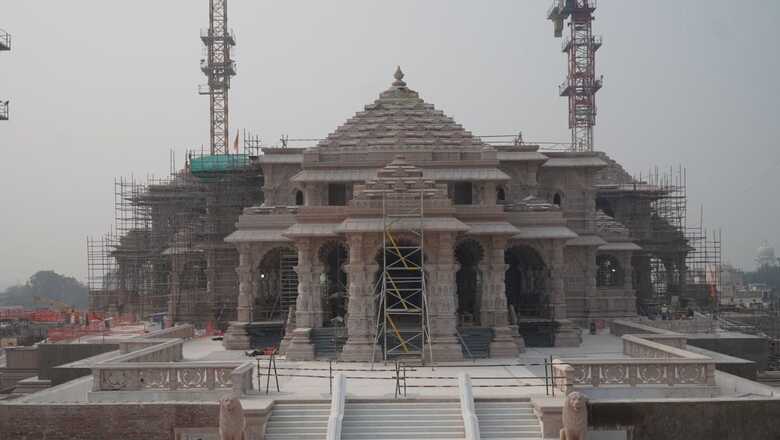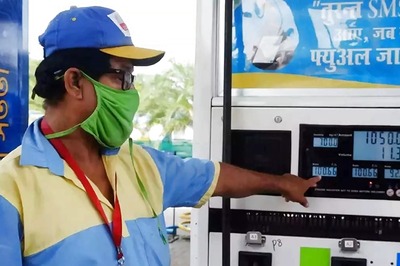
views
Preparations are in full swing for the highly-anticipated ‘pran pratishtha’ or consecration ceremony of Lord Ram Lalla at the Ram Temple in Ayodhya. The ceremony will take place in the garbha griha (sanctum sanctorum) of the temple at 12:20 pm on January 22, 2024. The idol depicting the 5-year-old child form of Lord Ram will be housed.
ALSO READ: What is ‘Garbh Griha’? ‘Largest Across Temples Globally’, Decoding Ayodhya Ram Mandir’s ‘Dark’ Innermost Part
Built in an overall area spanning 71 acres, the grand temple complex is divided into six parts, including the sanctum sanctorum and five pavilions—Gun Mandap, Rang Mandap, Nritya Mandap, Kirtan Mandap, Prarthana Mandap. The temple is 161 feet high, with three floors, each 19.5 feet.
अयोध्या में निर्माणाधीन श्रीराम जन्मभूमि मंदिर की विशेषताएं:1. मंदिर परम्परागत नागर शैली में बनाया जा रहा है।
2. मंदिर की लंबाई (पूर्व से पश्चिम) 380 फीट, चौड़ाई 250 फीट तथा ऊंचाई 161 फीट रहेगी।
3. मंदिर तीन मंजिला रहेगा। प्रत्येक मंजिल की ऊंचाई 20 फीट रहेगी। मंदिर में कुल… pic.twitter.com/BdKNdATqF6
— Shri Ram Janmbhoomi Teerth Kshetra (@ShriRamTeerth) January 4, 2024
Here are the features of the grand temple complex in Ayodhya –
1. According to the Shri Ram Janmabhoomi trust, the three-storied temple is built in the traditional Nagar style with each wall measuring 20 feet. No iron is used in the construction of the temple anywhere.
2. It has a length (east-west) of 380 feet, a width of 250 feet, and a height of 161 feet.
3. The complex has a total of 392 pillars and 44 doors.
4. The childhood form of Bhagwan Shri Ram (the idol of Shri Ram Lalla) is in the sanctum sanctorum and on the first floor, there will be a Shri Ram Darbar.
5. The complex also encompasses five mandaps (Hall) – Nritya Mandap, Rang Mandap, Sabha Mandap, Prarthna and Kirtan Mandaps.
6. Statues of deities, gods, and goddesses adorn the pillars and walls of the temple.
7. Entry into the temple is from the east, ascending 32 stairs through the Singh Dwar.
8. The temple complex also provides ramps and lifts for the convenience of the differently-abled and elderly.
9. The Parkota( Rectangular compound wall) measuring 732 meters and a width of 14 feet surrounds the temple.
10. At the four corners of the complex, there are four temples – dedicated to Surya Dev, Devi Bhagwati, Ganesh Bhagwan and Bhagwan Shiv. In the northern arm is a Mandir of Maa Annapurna and in the southern arm is a Mandir of Hanuman ji.
11. A historic well named ‘Sita Koop’ is situated near the temple.
12. Inside the Ram Mandir complex, there are proposed temples dedicated to Maharshi Valmiki, Maharshi Vashishtha, Maharshi Vishwamitra, Maharshi Agastya, Nishad Raj, Mata Shabri, and the revered consort of Devi Ahilya.
13. In the southwestern part of the complex, at Kuber Tila, the ancient temple of Bhagwan Shiv has been restored, and a statue of Jatayu has been installed.
14. The foundation of the temple has been made with a 14-meter thick layer of roller-compacted concrete (RCC), which gives it the appearance of artificial rock. Not only this, a 21-foot-high plinth has been constructed using granite to protect against ground moisture.
15. The Mandir complex also has a sewage treatment plant, water treatment plant, water supply for fire safety and an independent power station.
16. A Pilgrims Facility Centre (PFC) with a capacity of 25,000 people is being constructed, it will provide medical facilities & Locker facility to the pilgrims.
17. The complex also has a separate block with a bathing area, washrooms, washbasin, open taps, etc.
18. The temple also has statues of elephant, lion, Hanuman Ji & Garuda installed at the entrance gate, mounted on tiered slabs put up on both sides of the steps. These statues are sculpted from pink sandstone sourced from Rajasthan’s Bansi Paharpur village.
श्री राम जन्मभूमि मन्दिर के प्रवेश द्वार पर आज गज, सिंह, हनुमान जी और गरुड़ जी की मूर्तियाँ स्थापित की गईं हैं।ये मूर्तियाँ राजस्थान के ग्राम बंसी पहाड़पुर के हल्के गुलाबी रंग के बलुआ पत्थर से बनी हैं।
Murtis of elephant, lion, Hanuman Ji & Garuda have been installed at the… pic.twitter.com/ACINxlum0p
— Shri Ram Janmbhoomi Teerth Kshetra (@ShriRamTeerth) January 4, 2024
19. These statues were installed at the main entrance leading to the temple on Thursday, the senior official of the temple trust was quoted by PTI as saying.
20. The mandir has been constructed entirely using India’s traditional and indigenous technology with particular emphasis on environmental-water conservation with 70% of the 70-acre area left green.
Lion Gate or ‘Singh Dwar’ of Ram Mandir
The main entrance to the temple will be the Lion Gate or the ‘Singh Dwar’, which is constructed using the Rajasthani sand pink stone in the Nagar style. Both sides of the gate have floral designs. It took a total of three months for the construction of the gate.
श्री राम जन्मभूमि मंदिर का भव्य सिंहद्वारThe Magnificent Sinh Dwar of Shri Ram Janmbhoomi Mandir.
Ayodhya pic.twitter.com/1BhjPpJh2N
— Shri Ram Janmbhoomi Teerth Kshetra (@ShriRamTeerth) January 4, 2024
Prime Minister Narendra Modi is set to address attendees at the grand consecration event from the ‘Singh Dwar’.



















Comments
0 comment